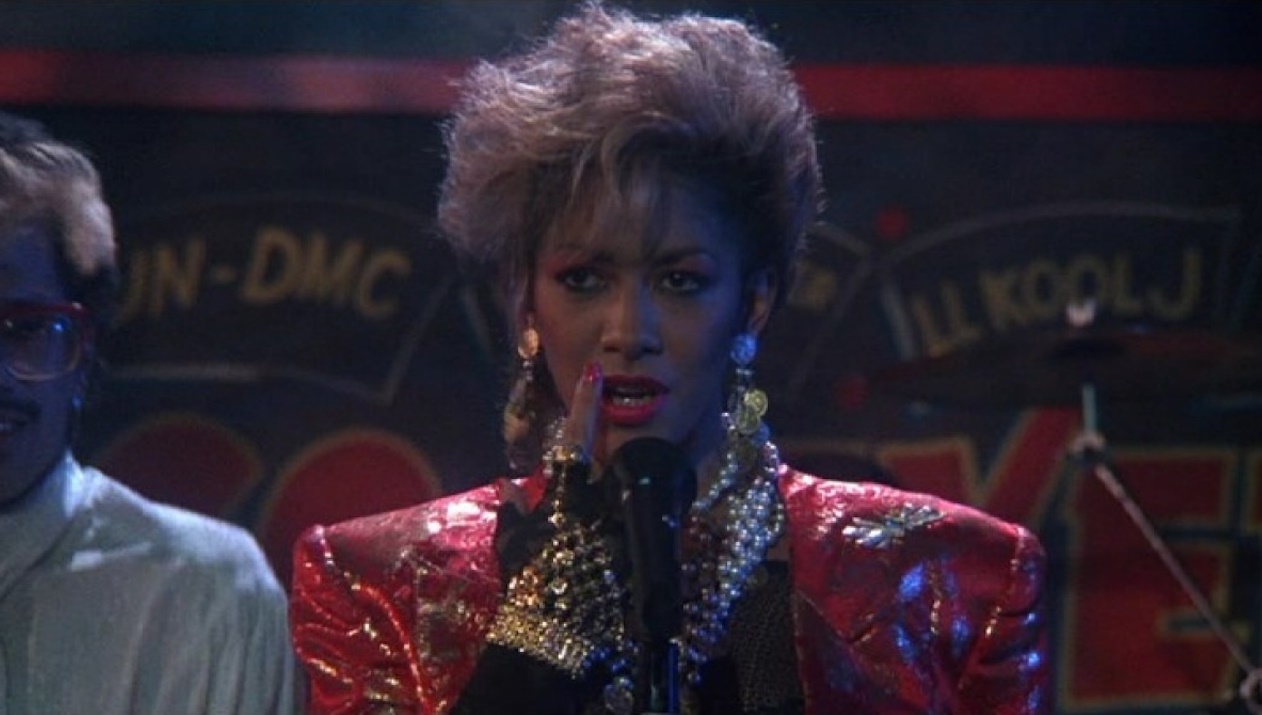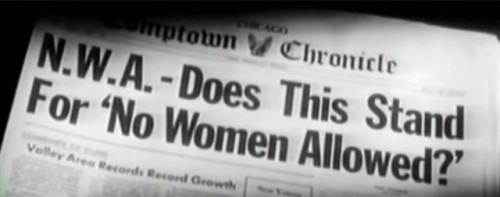This guest post written by Tara Betts appears as part of our theme week on Ladies of the 1980s.
The film Krush Groove opens with rap group Run–D.M.C. (Joseph “Run” Simmons, Darryl “D.M.C.” McDaniels, and Jason “Jam Master Jay” Mizell) recording “King of Rock” in a makeshift studio for producers Rick Rubin (as Rick), Kurtis Blow (playing himself, as did most of the musicians in the film), and Blair Underwood (as Russell Walker), loosely based on Russell Simmons’ life. Two quiet girls listen in the studio, and the other group featured in the opening as the credits roll include The Fat Boys featuring the late Darren Robinson, also known as Human Beatbox. The Fat Boys (called The Disco Three here) portray high school students who dream of being famous rappers. Women and girls had minor roles or silent roles in the background. But one woman who received top billing and appeared on the posters in this 1985 film was none other than singer, drummer, and percussionist Sheila E., playing herself in the film. Shortly after drumming during Purple Rain with friend and collaborator Prince, the success of Sheila E.’s first single and album The Glamorous Life and the single “The Belle of St. Mark” helped her segue into her role in Krush Groove.
“The Love Bizarre” is heard before Run DMC even enters the tiny club called Disco Fever, where snippets of “King of Rock” are shot and The Disco Three dream of getting onstage. Sheila E.’s flyness come off with a singular style — asymmetrical short hair with bleached tips and gold coins dangling from her ears, her strings of pearls, a shimmery orange jacket with padded shoulders, and a black fingerless glove. She has a magnetic presence and controls the stage; she sings on her back and slides along the length of the stage, then pops back up to sing the chorus with a big-haired band member mouthing Prince’s voice on the chorus of “A Love Bizarre.” In the meantime, Russell (Blair Underwood) and Run are both watching Sheila. She ends the performance with plucking a chord or two and walks offstage to confront her manager about getting her better gigs. Sheila E. asserting herself here is one of several scenes where she speaks her mind and acts with agency on her own behalf. Of course, a snippet of the Force MDs’ song “Tender Love” foreshadows the romantic interest between Russell and Sheila E. But Sheila E. represents a woman’s creative musical power in an early hip hop film dominated by male artists.
Sheila E. practices what becomes the song “Holly Rock” later in the film. While Run and Darryl sit on the couch, Sheila stops playing to tell Run to rehearse and stop ordering shell toe Adidas. She is not one of the background vocalists on either side of Kurtis Blow when he raps “If I Ruled the World” at a scene in a club. When Sheila E. joins Blow and Run–D.M.C. onstage at The Beverly, their wardrobe takes cues from Prince’s Edwardian style suits, but the more significant element is how Sheila E. occupies the entire stage. She plays timbales, throws her drumsticks in the air and catches them, sings while prancing from one end of the stage to the other, and works the microphone while effortlessly singing and rapping.

When Run and Darryl leave Krush Groove Records, Russell looks to sign Sheila E. as part of his last ditch efforts to pay back a loan shark. Later, after Sheila and Russell fall for each other, Sheila slaps Run for cursing and bashing her for having sex with Russell. She insists on going to help Russell when the loan shark sends bodyguards to the Krush Groove office/college dorm room. Sheila E.’s reprimand convinces Run to help defend his brother. In the closing scene at Disco Fever, The Fat Boys, Run–D.M.C., Kurtis Blow, all line the stage and kick a verse. Sheila rhymes on par with any of her counterparts, and it becomes evident that her rapping becomes a recurring skill in later songs like Prince’s “Beautiful Night.”
Sheila E.’s prowess with words is only part of what makes her role distinct in this film. She stands out because she is a skillful musician who mastered various instruments and she is not necessarily a rapper in a film dominated by the then successful Run–D.M.C., a teenage LL Cool J, pop sensation New Edition, the Beastie Boys, two members of the R & B group Full Force playing bodyguards, and the future Uptown Records founder and eventual president and CEO of Motown Records Andre Harrell as half of the rap duo Dr. Jekyll & Mr. Hyde.
Sheila E. grew up surrounded by significant musicians: her percussionist father Pete Escovedo; her uncle singer and songwriter Alejandro Escovedo, her uncle The Dragons frontman Mario Escovedo, her uncle Javier Escovedo, who founded the Zeros; her uncle percussionist Coke Escovedo, who performed in Santana and started his own band; and her godfather Tito Puente, a legend of mambo and Latin jazz percussion, associated with Fania Records and movies like The Mambo Kings and Calle 54. As a child surrounded by these influential musicians, it is not surprising that she honed her talents and eventually told Prince what she was making on tours with her father and other musicians, to which he replied, “Okay, I can’t afford you.”
After starring in Krush Groove, Sheila E. recorded and released Romance 1600. In 1987, Sheila E. recorded a self-titled album on Paisley Park Records that included the U.S. singles “Hold Me” and “Koo Koo.” The video for “Koo Koo” featured dancer Cat Glover and both women later appeared in the live concert movie Sign o’ the Times as members of the band.
As we consider hip hop’s presence in U.S. films and documentaries spanning the globe, it is also reasonable to consider that Sheila E. has one of the biggest roles for a woman that was written in the spate of films that began portraying hip hop culture. In addition to this, she starred in a musical vehicle outside of Prince’s poetic universe. Sheila E. was not in Purple Rain with singers/actresses Apollonia Kotero or Jill Jones, nor did she appear in Under the Cherry Moon (1986) where Kristin Scott-Thomas plays a wealthy romantic interest. Sheila did not require a hero like martial arts actor Taimak as Leroy Green opposite Laura Charles (portrayed by singer Vanity, Prince’s partner and collaborator) in The Last Dragon (1985) either.
Earlier hip hop films included the 1983 classic Wild Style with graffiti artist Lady Pink as Lee Quiñones’ love interest and Stan Lathan’s 1984 film Beat Street, which billed Rae Dawn Chong as its most well-known star. Chong’s character Tracy Carlson offers a television opportunity to DJ Kenny Kirkland, his breakdancing brother Lee, and the graffiti writer Ramon, but she is not necessarily the main character driving the plot of the film. Lucinda Dickey, a former Solid Gold dancer who was one of the main characters in Breakin’ (1984) and she reprises her role as Kelly/Special K in Breakin’ 2: Electric Boogaloo (1984). But her role as a classically trained dancer who went to learn from Ozone (Adolfo “Shabba-Doo” Quiñones) and Turbo (Michael “Boogaloo Shrimp” Chambers), both stigmatized as “street dancers,” offers a subtle critique against classist snobbery while still excluding women of color, even after Jennifer Beal’s stunning audition scene in the 1983 Flashdance where none other than Rock Steady Crew’s Crazy Legs acted as Beals’ breakdancing stunt double (in addition to stunt doubles dancer Marine Jahan and gymnast Sharon Shapiro).
Although Sheila E.’s notoriety skyrocketed during the 1980s, she continued in the subsequent decades to open musical doors as a musician. She was a bandleader on “The Arsenio Hall Show” and Magic Johnson’s short-lived “The Magic Show.” She released four albums after the 1987 release Sheila E. This Afro-Latinx percussionist continues to tour, perform at festivals, and share billing with notable musicians in various genres. Krush Groove was one place that showcased her talents just outside Prince’s umbrella. In 2014, she published a memoir The Beat of My Own Drum. Lately, she has been speaking with Prince’s surviving band members and coordinating events. Sheila E. also appeared in the BET tribute to Prince, along with The Roots, Bilal, Erykah Badu, Jennifer Hudson, Stevie Wonder, and Janelle Monae. Sheila E. led the electric finale with dancer and choreographer Mayte Garcia (and Prince’s ex-wife) and Jerome Benton dancing with a full crew of dancers and musicians. Sheila E. continues to captivate, entertain, and inspire audiences.
Tara Betts is the author of two full-length poetry collections Break the Habit and Arc & Hue. She is also the author of the chapbooks 7 x 7: kwansabas (Backbone Press, 2015), the upcoming Never Been Lois Lane (dancing girl press, 2016), and the libretto THE GREATEST!: An Homage to Muhammad Ali (Argus House/Winged City Press, 2013). Tara’s writing has appeared in The Source, XXL, Black Radio Exclusive, Essence, NYLON, and the hip hop-inspired anthology The Break Beat Poets.








